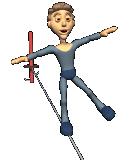
Text by Steve Gossard, Curator, ISU Circus Collection
In the last quarter of the 19th century, a few talented young men left Bloomington, Illinois to pursue careers peforming aerial acts in the circus ring. At the end of each circus season, they would return to their home town to practice. As artists, they developed their skills and perfected new tricks during these winter months. As businessmen, they sought new talent to expand their acts and offer more sensational performances. In time, Bloomington became the leading community for training performers for trapeze and other aerial acts. This fostered an environment of concern for skill and learning in the circus arts, and many young men and women tried their hands at these dynamic disciplines. Out of this environment of active pursuit came a talented young brother and sister act which would contribute much to establishing a standard for excellence in the profession.
Jennie Ward grew up on the poor side of town in Bloomington, Illinois. According to local legend, she and her brother, Eddie, had taught themselves to perform a daring two-person aerial act by slinging trapeze bars from the limbs of a thorn apple tree in their back yard. They ascended to the top of their profession while Jennie was still in her teens. From that time until her tragic death at the age of twenty-eight, Jennie was acknowledged to be one of the finest and most beautiful aerialists in the business.
Jennie, born December 8, 1889, was three years younger than her brother, Eddie. Their mother and father were divorced when the children were very young, and their mother made a meager living taking in washing. Eddie dropped out of school in the third grade to work as a butcher's helper. Eddie and Jennie began their performance career in 1904 working parks and fairs.
Eddie and Jennie began performing for the great Ringling Brothers' Circus in 1906. With the exception of the 1907 season, which they spent with the Van A mburgh Circus, Eddie and Jennie were with the Ringling show through 1912, performing a swinging ladders act as well as their double trapeze. A double trapeze consists of one trapeze hanging above another. From this the aerialists perform a series of contortions, flips, and drops and catches. The act was performed without a net or safety device of any kind. At the height of their career, the Wards' double trapeze performance consisted of eight or more stunts, and took seven minutes. Two of their stunts, the foot-to-foot catch and the break-away trick, were said to be innovations of the Wards.
On August 19, 1911 the Billboard magazine reported an incident which occurred in Grand Island, Nebraska with the Ringling Brothers' Circus:
Miss Jennie Ward, one of the Flying Wards, high trapeze artists with Ringling Bros.' Show fell from the top of the tent with the afternoon performance last Thursday. Since the team worked without a net of any kind, she fell with a great force to the ground, and is said to be probably fatally injured internally.
Jennie had fallen flat against the ring curb (the wooden circle which makes up the circus ring) forty feet below so hard that her neck actually split a two-by-four in half. But the report of the seriousness of her injury was premature. Jennie did recover from the effects of the fall, which her brother, Eddie later said (May, Earl Chapin, Grab It, American Magazine, July 1928) had left her back bowed like a horseshoe. She treated herself with a grueling and painful form of physical therapy, pulling herself up every day on the tent ropes. "It was punishment of the toughest kind," Eddie said. Within a year Jennie was working in their aerial act again.
In 1912 Eddie married Mayme Fay Harvey, a young woman with the Hines-Kimball troupe of acrobats; and Jennie married Alec Todd, an aerialist with the Herbert Brothers act. These four would make the nucleus of the original Flying Wards flying return act. In a flying return act, one trapeze artist (the flyer) stands on a narrow platform, and swings off on a trapeze bar (the flybar). He is caught by another aerialist (called the catcher) who swings by his hocks from another trapeze (the catchbar). The two complete their swing and the flyer is returned to the pedestal board by way of the flybar.
The Wards left the Ringling show in 1912. They toured Europe with their new act and returned to America, having recruited new people to the act for the 1913 season. In 1913, the Wards built a practice barn at Center Point, Iowa. The Center Point barn was hardly used, for in about 1915 Eddie built another barn on Emerson Street in Bloomington, Illinois. It was here that the Wards established their permanent winter quarters. From 1914 until 1918 the Wards contracted to provide their flying return act for the Hagenbeck-Wallace Circus. The winter of 1916-1917 they also toured Cuba. Early one morning in June of 1918, the circus train in which the troupe was riding was sitting on a siding at Ivanhoe, Indiana when an empty troop train rammed it from behind at full speed. Eddie, Mayme and Alec survived the wreck, but Jennie and another girl with the act were killed. Eddie had pulled Jennie out of the wreckage, but she was pronounced dead at the scene of the accident. Family members state that Jennie was pregnant at the time of her death. Other fatalities of the wreck, burned beyond recognition, were buried in a mass grave. Jennie was returned to Bloomington and buried at Park Hill Cemetery.
Eddie and Jennie Ward had begun an unparallelled tradition of aerial training in Bloomington, Illinois. In the early years, Jennie helped to establish a standard of excellence which carried over through future generations of trapeze artists. As time went on Eddie trained dozens of the finest aerialists in the country at the practice barn on Emerson Street. The reputation which Jennie and Eddie earned in double trapeze performance has never been surpassed.
Thursday, August 20, 2009
....Jennie Ward....
Labels: .circus.
Subscribe to:
Post Comments (Atom)














0 comments:
Post a Comment